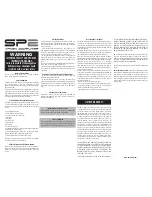
7.3.1 CRBasic programming
The WindSonic1 updates the RS-232 output to a user-set frequency. CRBasic data loggers use
SerialInRecord()
to retrieve the latest record sent by the WindSonic1 at the scan interval.
This ensures that the most current wind data is available for use by the program.
The data logger and WindSonic1 each use their own internal clocks. These clocks are not
perfectly synchronized with each other and will drift in and out of phase. This phase drift could
cause missed samples because no new data was transmitted to the data logger in time for the
next scan. The data logger program can record the number of missed samples, which will occur if
the WindSonic1 is disconnected from the serial port, the WindSonic1 has no power, or the data
logger and WindSonic1 clocks have drifted out of phase by one cycle. The example programs
available at
www.campbellsci.com/downloads/windsonic1-program-examples
record the
number of missed records.
NOTE:
For the CR800-series, CR3000, and CR1000 data loggers, early versions of the data logger
operating systems (OS) did not support serial communication using control terminals or the
SerialInRecord()
instruction. It may be necessary to update the data logger OS. The
most current data logger operating systems are available on the Campbell Scientific website
at:
.
7.4 Siting
Locate the WindSonic1 away from obstructions such as trees and buildings. The distance
between wind sensors and the nearest obstruction should be ten times the height of the
obstruction. If it is necessary to mount the WindSonic1 on the roof of a building, the height of the
sensor, above the roofline, should be at least 1.5 times the height of the building. See
(p. 15) for a list of references that discuss siting wind direction and speed sensors.
7.5 Mount the sensor
Mount the WindSonic1 using the WindSonic Mounting Pipe Kit, which consists of an aluminum
mounting tube, three pan truss screws, CM220 Right Angle Mounting bracket, two U-bolts, and
four nuts.
1. Thread the connector end of the cable through the mounting tube; start at the end without
the three threaded holes.
WindSonic1 Two-Dimensional Sonic Anemometer
9













































